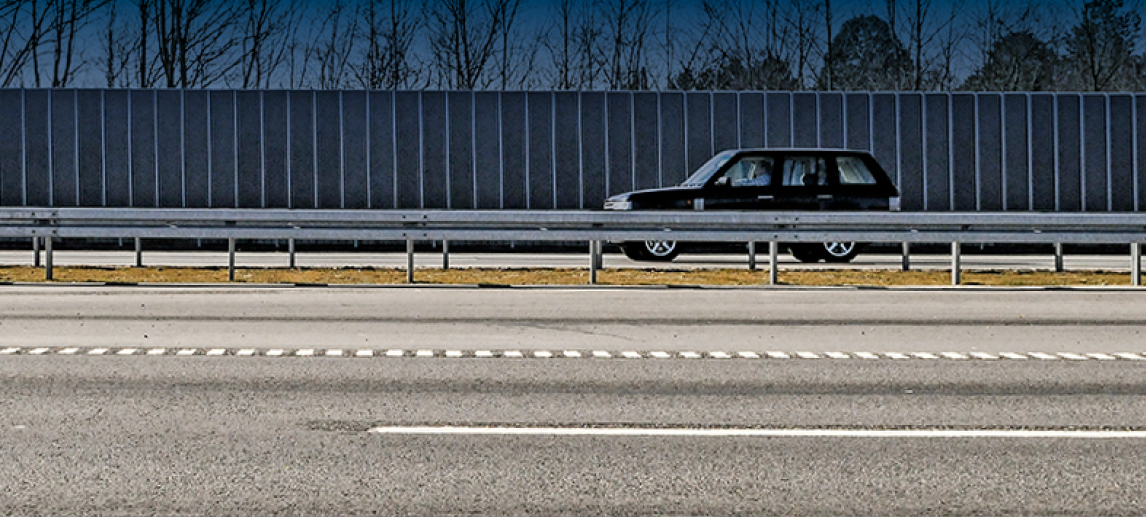Auralisation: What does a motorway sound like?
Noise is often a big issue in public debates about new road projects. It is only natural that neighbours and other interested parties would like to know how the project will affect the surroundings. Here, the use of auralisations presented at public meetings is a huge improvement to explain the scope and impact of road noise.
Today, the usual way of explaining the noise impact of a project is by calculating the noise impact on the surroundings and illustrating the impact using a noise map. The noise maps are accompanied by text and tables with calculations of the number of noise affected houses in relation to the Danish EPA’s recommended noise limits. The term “noise affected” is often used about a house where the recommended noise limit for outdoor noise has not been complied with.
Defining and measuring noise and noise impact is extremely difficult, however. It can be difficult, both for the layman as well as for many technicians, to relate to the dB scale on a map or in words. A typical misunderstanding is that as long as the EPA’s noise limits are complied with, then there will not be any significant noise impact. This is not correct. The recommended limit values for noise correspond to around 8-10 % of the population being highly annoyed living where the noise impact is 58 dB, which corresponds to the recommended noise limit for residential areas. New studies from the Danish Road Directorate show that if a new motorway is built, around 20 % of local residents will be highly annoyed at 58 dB.
In 2016-17, the Danish Road Directorate conducted an EIA study for a new motorway between Næstved and Rønnede. Various proposals and variations were examined for an expansion of Route 54. The noise impact was described for each of the proposals.
Read also: Listen to the road of the future


Presentation of auralisations at public meetings
For the public hearing of the EIA study, a number of auralisations were presented at public meetings on the project. The purpose of the auralisations was to give local residents an idea of how the future motorway would affect them in terms of noise. It was also intended as a way of demystifying the noise impact, for example the myth that noise cannot be annoying as long as it stays within the recommended limit values.Examples were presented of how the motorway would sound at three specific sites (positions) along route A (north proposal). In principle, examples can be used along the other routes at the same distances to the road if traffic conditions and the propogation of the sound are otherwise quite identical.
The use of these sound examples, or auralisations, at public meetings is not entirely new. Auralisations have previously been recorded for public meetings, where they have been used to present the effect of a noise barrier, noise-reducing asphalt etc.

The recorded auralisations can be downloaded via this link (speak is in Danish).
Other presentations are available (in English) via this link.
Reactions at public meetings
Judging by the interest at the meeting, the recorded auralisations were a good supplement to the hearing’s written material. It had been expected that about three presentations would be shown, but this was far from enough. The auralisations were presented to upwards of 200 local citizens, so the expected number of presentations exceeded all expectations, as there could be a maximum of 25 people per presentation.
The following day, the Danish Road Directorate had arranged an “open house” at the community centre in Holme-Olstrup. It was possible here throughout the day to obtain more detailed information about the project. The auralisations were actively used as a starting point to talk about how a motorway would affect the local area.
Naturally not all local residents are happy about the road project, which, all other things being equal, means the addition of a new noise source. However, the consequences of the new motorway have been explained in a more detailed and accessible way than has been the usual practice in the past. Noise doesn’t disappear just because auralisations are presented at a public meeting, but the expectations about the noise generated by a future motorway are better balanced if there is the opportunity to hear the consequences beforehand.
Related content
Auralisations: The sound of road noise
/Article
Listen to auralisations of traffic noise i different situations.
Distance and terrain
/Article
How much does terrain and distance influence traffic noise?
Express- and motorway noise
/Article
Listen to the noise at different distances.
How does noise reduction sound?
/Article
Changes of 3, 6 and 10 dB.
Noise reduction from vegetation
/Article
Find out what it takes for vegetation along the roadside to work as noise reduction.
Noise reduction measures
/Article
Examples of a motorway with and without noise reduction measures.
Næstved-Rønnede motorway
/Article
Presentation of sound samples (auralisation) for the Næstved-Rønnede motorway.
Road surface age
/Article
The road surface age also influences the road noise.
The wind's influence on road noise
/Article
Listen to the influence of wind speed and wind direction on the noise from a motorway.

